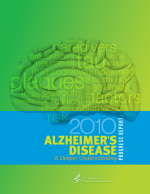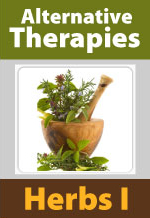Excerpted from the National Center for Complementary &Alternative Medicine (NCCAM) Publication Herbs at a glance: A quick guide to herbal substances, 2010.
In the United States, nearly 1 in 5 adults—or over 38 million people—reported using a natural product, such as herbs, for health purposes in a 2007 survey. Among the top 10 natural products used were several botanicals covered in this booklet: echinacea, flaxseed, ginseng, ginkgo, and garlic.
People have used herbs as medicine since ancient times. For example, aloe vera’s use can be traced back to early Egypt, where the plant was depicted on stone carvings. Known as the “plant of immortality,” it was presented as a burial gift to deceased pharaohs. Lavender, native to the Mediterranean region, was used in ancient Egypt as part of the process for mummifying bodies. Chasteberry, the fruit of the chaste tree, has long been used by women to ease menstrual problems and to stimulate the production of breast milk. Cat’s claw, which grows wild in Central and South America, especially in the Amazon rainforest, has been used for centuries to prevent and treat disease. Hoodia, a flowering, cactus-like plant native to the Kalahari Desert in southern Africa, has been used by the Kalahari Bushmen to reduce hunger and thirst during long hunts.
Herbs still play a part in the health practices of many countries and cultures. Ayurvedic medicine, which originated in India, uses herbs, plants, oils, common spices(such as ginger and turmeric), and other naturally occurring substances. Traditional Chinese medicine uses herbs such as astragalus, bitter orange, and ginkgo for various health conditions. Herbs are also an important part of Native American healing traditions. Dandelion and goldenseal are examples of herbs used by Native Americans for different health conditions.
NCCAM’s Research on Herbs
While millions of Americans use herbal supplements, much remains to be learned about their safety and effectiveness. The National Center for Complementary and Alternative Medicine (NCCAM) at the National Institutes of Health is the Federal Government’s lead agency for studying all types of complementary and alternative medicine, including herbal supplements. This research covers a wide range of studies—from laboratory-based research studying how herbs might affect the body, to large clinical trials testing their use in people, such as studying ginkgo’s effects on memory in older adults, or whether St. John’s wort may help people with minor depression. Exploring how and why botanicals act in the body is an important step in evaluating their safety and effectiveness.
A word about safety
Although herbs have been used for thousands of years as natural medicines, natural does not always mean safe. Herbs can act in your body in ways similar to prescription drugs, and herbs may have side effects. They may also affect how your body responds to prescription drugs or over-the-counter medicines you take—possibly decreasing or increasing their effects.
How are herbal supplements regulated?
The U.S. Food and Drug Administration (FDA) regulates herbal and other dietary supplements differently from conventional medicines. The standards of safety and effectiveness that prescription and over-the-counter medicines have to meet before they are marketed do not apply to supplements. The standards for supplements are found in the Dietary Supplement Health and Education Act (DSHEA), a Federal law that defines dietary supplements and sets product-labeling standards and health claim limits. To learn more about DSHEA, visit the FDA Web site at www.fda.gov/RegulatoryInformation/Legislation/ .
Use Caution
If you are considering or using an herbal supplement, think about these points:
• Some herbal supplements are known to interact with medicines (both prescription and over-the-counter). For example, St. John’s wort can interact with birth control pills.
• Research has shown that what’s listed on the label of an herbal supplement may not be what’s in the bottle. You may be getting less—or more—of an ingredient than the label indicates, even if it uses the word “standardized” or “certified.” Many factors, including manufacturing and storage methods, can affect the contents of an herbal product.
• Some herbal supplements have been found to be contaminated with metals, unlabeled prescription drugs, microorganisms, or other substances.
• If you use herbal supplements, it is best to do so under the guidance of a medical professional who has been properly trained in herbal medicine. This is especially important for herbs that are part of a whole medical system, such as traditional Chinese medicine or Ayurvedic medicine.
• Women who are pregnant or nursing should be especially cautious about using herbal supplements. This caution also applies to giving children herbal supplements.
Talk to Your Health Care Providers
Be an informed consumer. Tell all of your health care providers about any herbs or supplements you are using or considering. Your health care providers need a full picture of everything you do to manage your health, including all complementary and alternative medicine practices. This will help ensure coordinated and safe care. It is especially important if you are taking any prescription or over-the-counter medications that could interact with an herbal supplement.
If you would like the full text of this publication, it is in the public domain and available at no cost at http://nccam.nih.gov/health/herbsataglance.htm
If you would like to read this entire booklet and receive one hour of continuing education credit, visit Professional Development Resources at https://pdresources.org/course/index/1/1097/Alternative-Therapies-Herbs-I-What-Every-Clinician-Should-Know
More Free Resources:
- Acupuncture – An Introduction
- Attention Deficit Hyperactivity Disorder (ADHD)
- Frontotemporal Disorders
- Bipolar Disorder in Children and Adolescents
- The Challenge of Co-Parenting
- Adolescent Literacy
- Domestic Violence: Child Abuse and Intimate Partner Violence
- English Language Learning
- Helping Children Learn To Listen
- Ethics and Social Media
- Children’s Exposure to Violence







![Video2 Using structural MRI to map the functional anatomy of language and reading [electronic resource] / Cathy Price.](http://pdresources.files.wordpress.com/2011/08/video2.jpg?resize=330%2C394)
